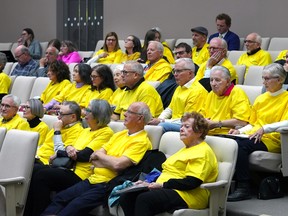Glenmore Landing controversy shows need for conversations on growth

[ad_1]
No one likes seeing their taxes going up, but a lot of us also seem to chafe at decisions that help keep taxes in check

Article content
The proposed mixed-use development at the Glenmore Landing shopping plaza in southwest Calgary took a turn when city council rejected it in an 8-6 vote last week.
Advertisement 2
Article content
Article content
Article content
The shopping centre’s owner, RioCan, had touted additional businesses and 1,165 housing units along the currently unused south and east edges of the property.
Much of the stated opposition was focused on the size of the proposal, rather than the general idea of adding more homes to the area.
Concerns voiced at a public hearing ahead of the vote included potential for traffic issues at the site.
This is a legitimate question seeing how the entire neighbourhood of Pump Hill, immediately south of the mall, only had 1,455 residences as of the 2021 census.
Traffic, at least, can be fixed.
But some perplexing arguments raised in opposition seemed more difficult to reconcile.
First were environmental concerns, despite the fact the proposed developments weren’t on the water side of the mall, but on the unused land separating the existing structures from 90th Avenue and 14th Street S.W. There would have been no loss of parkland.
Article content
Advertisement 3
Article content

As for impacts on the Glenmore Reservoir, stormwater control would certainly be a concern, but it’s worth pointing out all of the city’s stormwater systems already drain into the Bow and Elbow rivers, complemented with the use of storm ponds and possible natural filtration.
There are many big buildings in Calgary built close to the rivers with no particular everyday concerns about their impact on waterways. You can see them in Eau Claire and Downtown West — even as far as the western reaches of Parkdale.
While these examples are downstream of our drinking water source, it’s upstream of other people’s taps.
The Glenmore Reservoir is itself home to Rockyview General Hospital, which stands on the artificial lake’s eastern shore.
Advertisement 4
Article content
If there were concerns about domestic wastewater, fear not: Calgary’s household drains don’t discharge directly into our waterways.
There were aspersions cast on rapid transit serving the site: The proposed Glenmore Landing redevelopment couldn’t possibly be transit-oriented development because the Max station is just a glorified bus stop, it was argued.
Station design is irrelevant: Frequent service at boring bus stops can move impressive numbers of people.
BRT Route 301 on Centre Street North accounted for nearly 9,000 users a day in 2023. Thousands more the other buses rolling up and down that busy corridor daily —and only now has the city got around to building Max-style bus shelters for them.

There were also concerns about taxation, had the development gone ahead and required infrastructure improvements in the area to accommodate all the new people and new businesses moving in.
Advertisement 5
Article content
Here’s the beautiful thing about living in a city: area residents wouldn’t have been left to fend for themselves. All of Calgary would have paid for that together. (And in this case, it’s understood RioCan would have footed the bill for some of this, too.)
New residents in the development itself would eventually be paying their share of taxes, either directly or through their landlord.
And whatever the cost of upgrades would have been, it would have paled in comparison with the price tag of building a whole new subdivision from scratch and providing new services for it.
This is the heart of the entire densification debate.
No one likes seeing their taxes going up, but a lot of us also seem to chafe at decisions that help keep taxes in check. This includes trying as much as possible for the city to grow within its existing footprint, providing more tax revenues without also having to spread our resources ever more across a geographically larger city.
Despite the Glenmore Landing setback, RioCan should try again with a new design — something less intense that will also be acceptable to those living nearby. Every little bit helps.
And with hope, this entire experience will result in a meaningful, productive, sustained conversation about how Calgary can grow in a more responsible manner.
Recommended from Editorial
-

Dozens sign up to speak out on Glenmore Landing redevelopment
-

Residents to oppose Glenmore Landing ‘mini-city’ at council hearing
Article content






